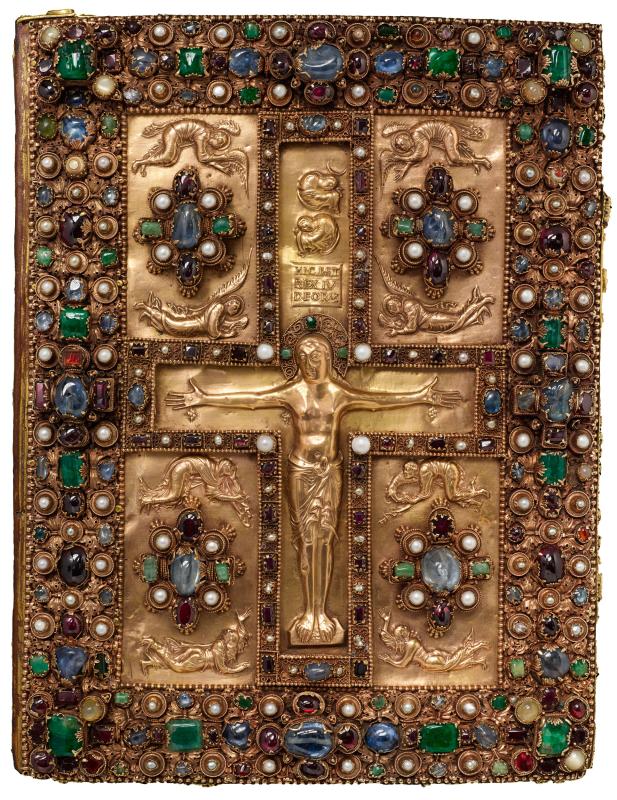Lindau Gospels

Download image:
Accession number:
MS M.1
Title:
Lindau Gospels
Created:
St. Gall, Switzerland, between 880 and 899.
Binding:
Front cover is one of most important extant medieval jeweled bindings; one of 3 contemporary pieces of Carolingian goldsmiths' work ascribed to the so-called court school of Emperor Charles the Bald, grandson of Charlemagne, executed ca. 880; decoration is dominated by a large gold repoussé figure of Christ crucified on a jeweled cross, 10 other repoussé figures in mourning poses within 4 surrounding quadrants; a raised jeweled border runs around this configuration; back cover was made probably in or around Salzburg, 750-800, executed in gilt silver, enamel, decorated with jewels; date and origin of this cover are uncertain because its components point to different times and places. The front and back book covers are attached to wooden boards. Patterned Byzantine silk doublures inside front cover and patterned Islamic silk doublures inside back cover, ca. 8th-10th century. Library also has a replica of the back cover (cataloged separately).
Credit:
Purchased by J. Pierpont Morgan (1837-1913) in 1901.
Description:
224 leaves (1 column, 21 lines), bound : vellum (some purple), ill. ; 320 x 253 mm
Provenance:
Owned in the 16th century by the abbey of aristocratic canonesses of Our Lady under the Lindens, at Lindau, an island in Lake Constance; at the secularization of the abbey in 1803 the Gospels were given to Canoness Antoinette, Baroness von Enzberg; on her death her heirs sold it to Baron Josef von Lassberg, who sold it in 1846 to Henry G. Bohn, agent for the Earl of Ashburnham; the Earl of Ashburnham; on the recommendation of Junius S. Morgan (1867-1932) purchased by J. Pierpont Morgan (1837-1913) in 1901 from the Earl of Ashburnham heirs; J.P. Morgan (1867-1943).
Notes:
Gospel book; written and illuminated in the Abbey of St. Gall, Switzerland, 880s to 890s.
Scribe: possibly Folchard, who also may have been the artist.
Decoration: four title and four incipit pages in gold on vellum stained purple; twelve canon tables on purple backgrounds, lettered in gold and silver; 2 carpet pages.
Script:
Carolingian minuscule
Language:
Latin
Resources:
Century:
Catalog Link:
Classification:
Department:

Named after the Abbey of Lindau on Lake Constance (Germany), where it was once housed, the Lindau Gospels ranks as one of the great masterpieces from the collection of the Morgan Library & Museum. Its jeweled covers constitute one of the most important of all medieval treasure bindings. Quite unusually, the manuscript's exquisite covers are in fact from entirely different regions and moments in time. Dating to the late eighth century, the back cover is the earliest component of the book and was likely made in the region around Salzburg (Austria). The front cover, in contrast, dates to nearly a hundred years later (ca. 870-80) and was likely produced in what is today eastern France. The manuscript itself is later still (ca. 880-90), and was certainly written and illuminated in the monastery of St. Gall (Switzerland). At some unknown point in time, precious silks from Byzantium and the Middle East were attached to the inside covers of the manuscript, thus adding yet another layer of complexity to this fascinating object.
The manuscript itself contains the text of the four Gospels along with standard supplementary material, such as the prologues of Jerome, prefaces for each of the Gospels, chapter listings, and twelve richly illuminated canon tables. Clearly inspired by textile designs, the two decorative pages that frame the manuscript's canon tables, are a particularly unusual feature of the manuscript's illumination. Nothing quite like them exists in any other manuscript from the period. As many as seven different scribes were engaged in the copying of the texts, and it is thought that a monk named Folchart--one of St. Gall's preeminent artists--was personally responsible for some of the manuscript's illuminated pages.